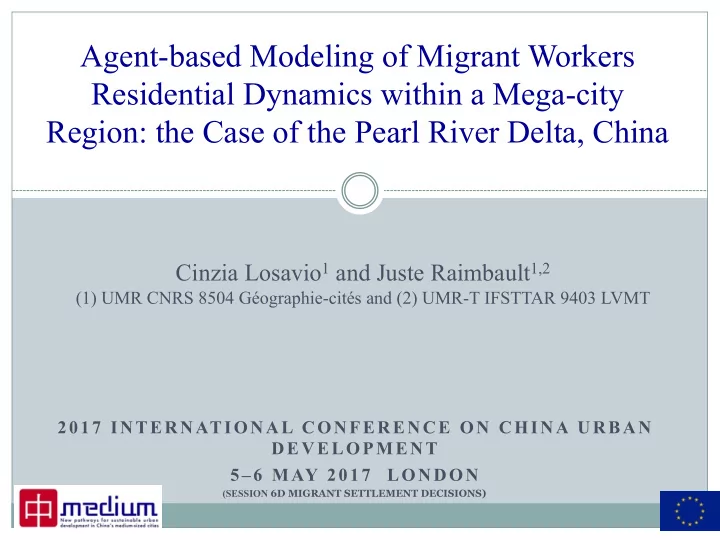

Agent-based Modeling of Migrant Workers Residential Dynamics within a Mega-city Region: the Case of the Pearl River Delta, China Cinzia Losavio 1 and Juste Raimbault 1,2 (1) UMR CNRS 8504 Géographie-cités and (2) UMR-T IFSTTAR 9403 LVMT 2017 INTERNATIONAL CONFERENCE ON CHINA URBAN DEVELOPMENT 5–6 MAY 2017 LONDON (SESSION 6D MIGRANT SETTLEMENT DECISIONS)
MEDIUM is led by CNRS, hosted by Géographie-cités and co-financed by the European Union. Scientific coordinator: Pr. Natacha AVELINE-DUBACH • PARTNERS : COORDINATOR INSTITUTION : CNRS (France); 4 CO-APPLICANTS : Hangzhou Normal University in China, Science Po Aix in France, Ca’ Foscari University in Italy, Spatial Foresight GmbH in Luxembourg; 2 ASSOCIATES IN SWITZERLAND: the universities of Lausanne and Neuchatel • THREE MEDIUM-SIZED CITIES : Hangzhou, Zhuhai and Datong • OBJECTIVE : to study the socio-economic and urban development dynamics • INTERESTS : urban governance, strategic planning, urban mobility, inclusion of migrants, ICT or networks of multinational corporations.
Mega-city regions « Mega-city regions (MCRs) are integrated sets of cities and their surrounding suburban hinterlands across which labor and capital can be reallocated at very low cost » (Florida, Gulden & Mellander, 2008). Main characteristics: Ø Globally connected (Hall and Pain, 2006) Ø Symbiosis between urban and rural areas Ø Migration flows Ø Density of connections Ø Regional migration patterns ( Mu and Yeh, 2016 )
Pearl River Delta (PRD) : the most prosperous and dynamic mega- city region in terms of migration waves Picture by Cinzia Losavio, 2016 The Pearl River Delta Region in China Source: Invest HK, 2010
PRD Mega-city region characteristics Polycentrism In 2015, the PRD accounted for: Ø 4.3% of China’s total population Ø 9.1% of China’s GDP Ø 26.8% of China’s total export
This agent-based model simulates migrants residential patterns taking into account the full range of migrants’ socio-economical status 3 dimensions to discern migrant workers diversity RESIDENTIAL GENERATIONAL PROFESSIONAL Picture by Cinzia Losavio, Zhuhai, 2017 Picture by Cinzia Losavio, Zhuhai, 2017 Picture by Cinzia Losavio, Zhuhai, 2017
Main qualitative lessons from baseline model exploration: qualitative interpretation The model shows that in real situation the regime of job congestion dominates The importance of accessibility relative to the cost of life does not influence much dynamics at a macro level The importance of the external factor relative to the cost of life and the accessibility has a “U-shaped” influence on the role of time
Hybrid Agent-based Modeling Agent-based Modeling : from toy to fully parametrized models, to infer indirect knowledge on processes in Complex Systems. Recent trends : Pattern-oriented Modeling (Grimm et al., 2005) Multi-Modeling (Cottineau et al., 2015) High Performance Computing calibration (Schmitt et al., 2014).
Model Structure and Ontology
Migration Dynamics • Variety of economic profiles : migrants wealth w ~ g(w) • Corresponding Economic categories • Discrete Choice utilities include accessibilities, cost of life and risk aversion, and State regulations with control term h j (c)
Spatial Configurations Synthetic City System PRD Stylized Configuration
Results : Sensitivity Analysis Model implemented in NetLogo, explored with OpenMole (Reuillon et al., 2013), around 5 million simulations. Sensitivity to economic structure : Emergent qualitative behavior is not influenced by categories Wealth Distribution Width : Larger income inequalities yield stronger spatial inequities in job accessibility Income Growth : Larger enrichments when migrating induces a suboptimal regime for the larger category
Results : Application Evaluating Policies: category- DPR configuration : existence targeted policies control total of optimal behavior ranges number of migrations
Perspectives - Conclusion • External Validation still needs to be further conducted, through more fieldwork, interviews, possibly micro-data • Further developments : generational dimension ; more diverse socio- economic characteristics • Potential applications : planning, policy evaluation, processes understanding • Importance of integrated modeling (qualitative/quantitative) for the approach All code and data available for reproducibility at https://github.com/JusteRaimbault/MigrationDynamics
Reserve Slides Reserve Slides
Modeling Migration dynamics Modeling migrations in China : • (Zhang and Zhao, 2013) estimate discrete choice models to study the trade- off between migration distance and earning difference • (Fan, 2005) shows that gravity-based models can explain well inter- provincial migratory patterns • The positive association between wage gap and migration rates was obtained from time-series analysis in (Zhang and Shunfeng, 2003) • (Wu, 2006) : Empirical study of intra-urban migrants residential dynamics ABM of migrants dynamics : • (De Leon et al., 2007) : Border town in Mexico • (Xie et al., 2007) : agent-based model to simulate the emergence of Urban Villages • (Silveira et al., 2006) : Ising model of rural-urban migration • (Fernandez et al., 2005) : study of population characteristics to establish the relevance of a future ABM
Temporal Evolution At each time step : • Cities mesoscopic evolution (Gibrat’s laws and Scaling laws) ; patch level distribution through preferential attachment scheme • New migrants enter the city, settle given their social network ( 关系) • Discrete choice migrations (randomly drawn for each migrant) • Update migrants wealths and economic categories • Update accessibilities
Discrete Choice Utilities
Discrete Choice Probabilities
Policies Scenarisation “Merit-based” point systems to obtain urban Hukou, implemented differently depending on cities. -> Translated as N random cities having a fixed incentive for the upper class (hj < 0)
Parameters Summary
Indicators • Total migrants wealth gain • Total migrants social mobility • Cumulated utility difference in migrations • Inequalities are captured by the final ratio between socio-economic categories
Data sources • Economic Data : (Swerts, forthcoming), from economic census • Population Data : Grid Population of China, 1km resolution (Fu, 2010)
Model Implementation Implementation in NetLogo (Wilenski, 1999) ; High Performance Computing exploration with OpenMole (Reuillon et al., 2013) Synthetic Data : Synthetic city system
Internal Validation Internal validation by checking statistical convergence and establish number of repetitions needed
Baseline Behavior
Baseline Behavior
Sensitivity : Distribution Width
Sensitivity : Distribution Width
Real Configuration
Real Configuration
References
Recommend
More recommend